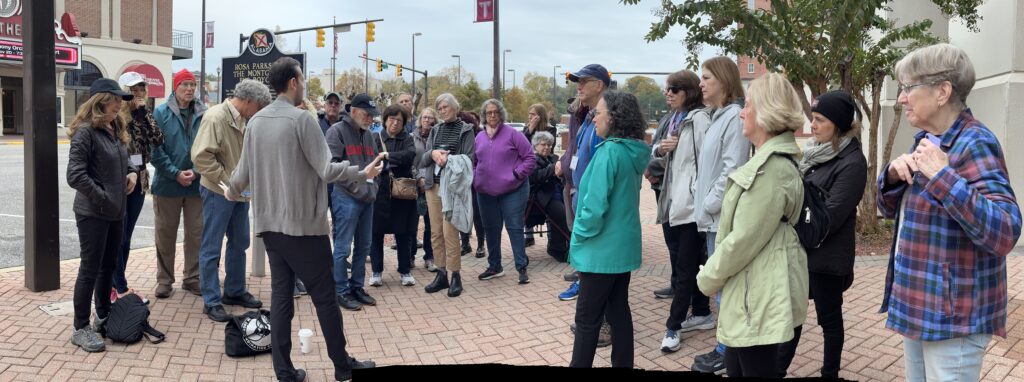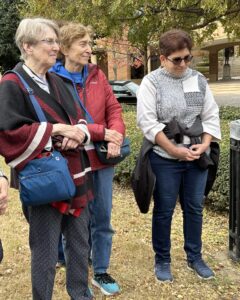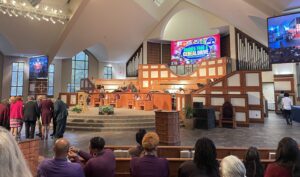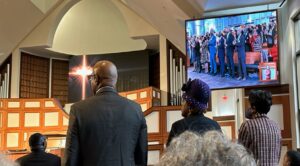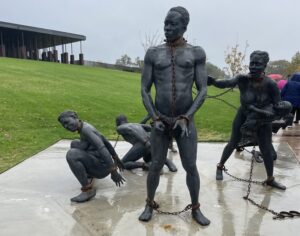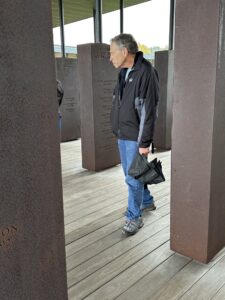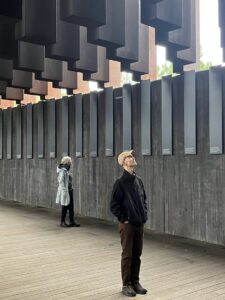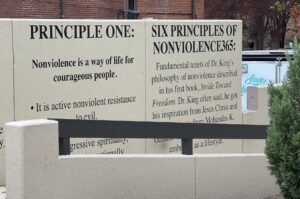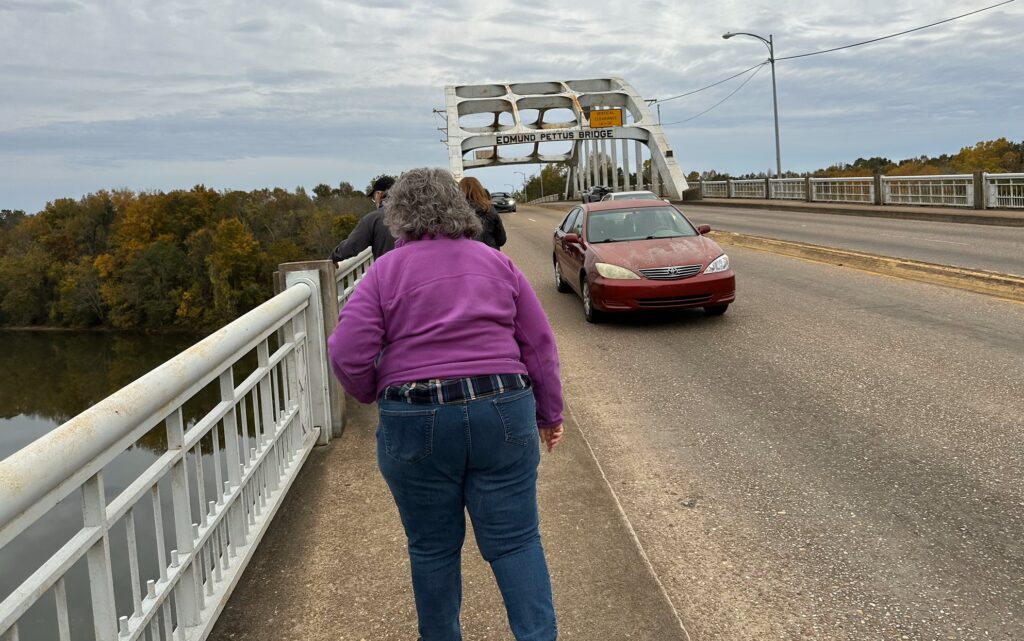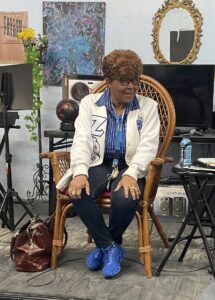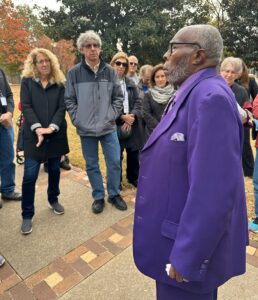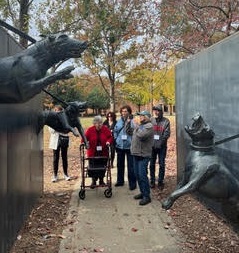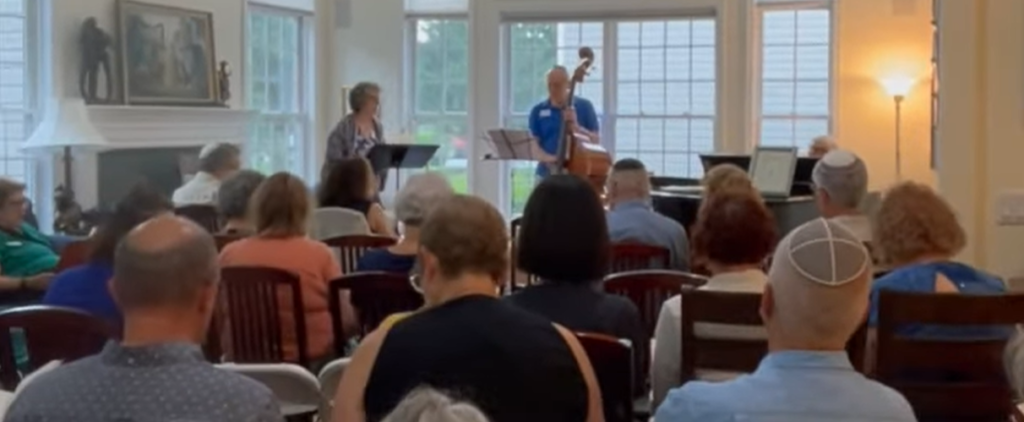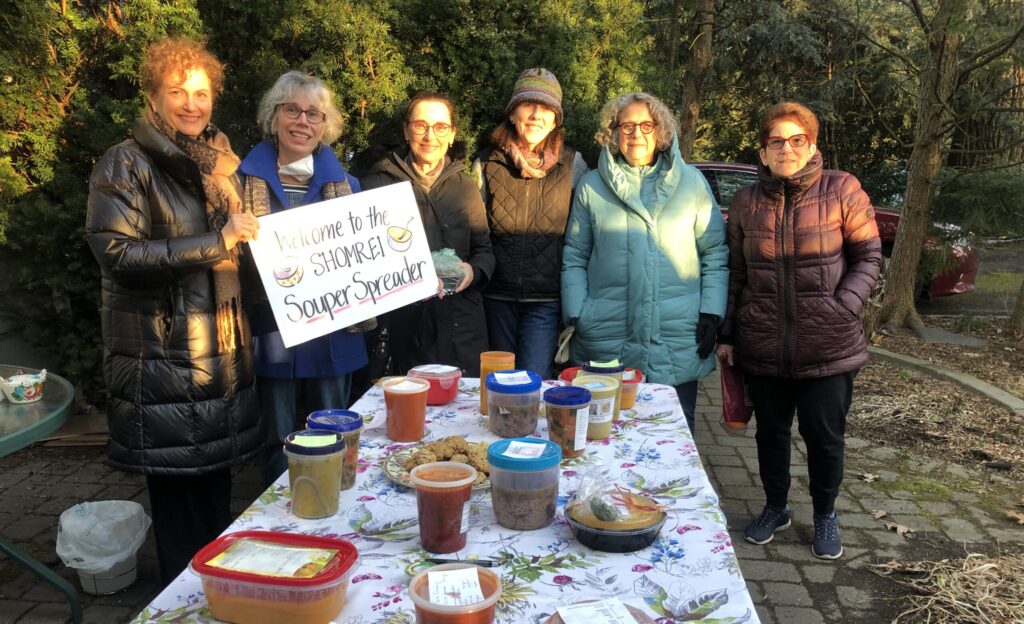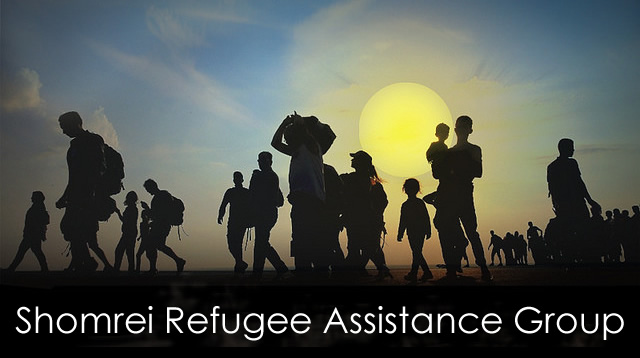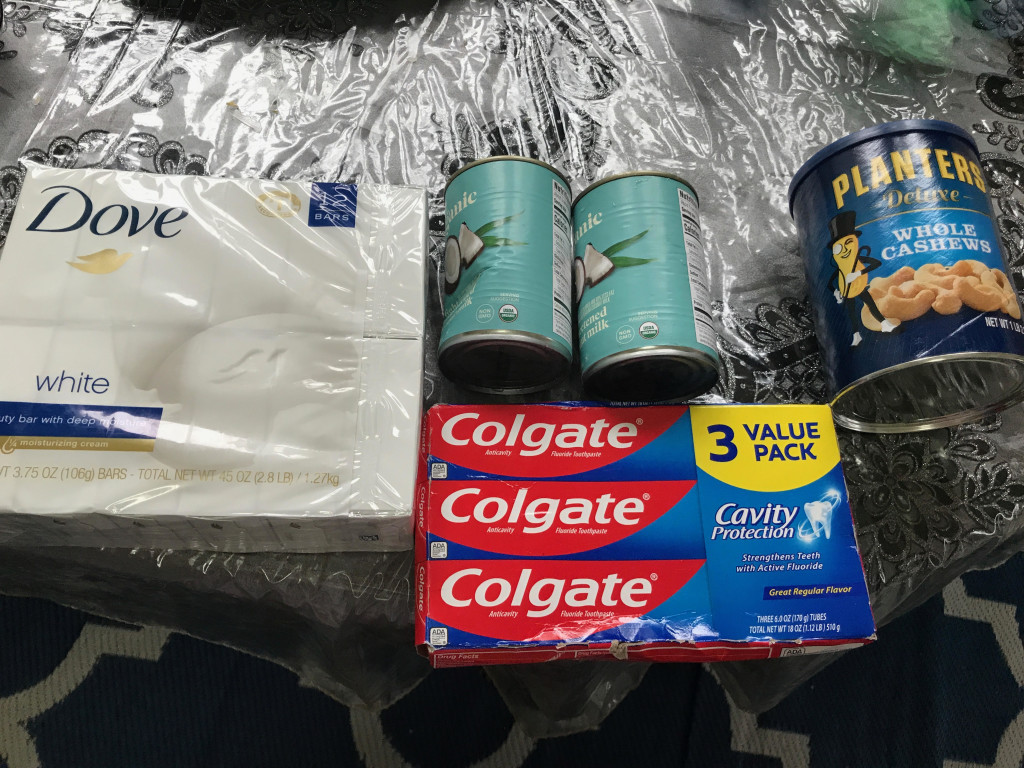Editor’s Note: Trip participants were asked to share one powerful and specific impression from the trip.
For me, the trip was about learning what I thought I had already learned.
Being born in 1959, the Civil Rights movement was part of my Social Studies classes throughout my Junior and Senior High School years. This trip made me realize I learned about select people and events presented in isolation of actual history and the movement in its entirety. I gained a different perspective of Black history in this country and a new understanding of current issues facing Black Americans in this country. You can only try to understand “walking in someone else’s shoes”, but you can never know what it is truly like.
SUNDAY SERVICE AT EBENEEZER BAPTIST CHURCH, ATLANTA GA
Actually, I was seriously impacted by the Pastor’s sermon at the Sunday morning service at the Ebeneezer Baptist Church in Atlanta. The message was the Garden of Gethsemene. And having one’s troubles while in the garden and being able to rely on faith and g-d and time and one’s inner strength to raise up and rise out of one’s misfortune and find the strength to prevail and overcome. While others saw this as just a prayer of hope for someone down on their luck in the black community, I saw it as a personal message to each individual (no matter from what community) to find strength in any challenging period of time in their lives. It was universal and spoke to me as much as any other sermon could.
Prior to entering the church we met in the park across the street. It was Veterans Day weekend, and our guide mentioned that during the church service they were going to honor veterans. Our guide went on to mention that after WW II black veterans were excluded from the GI bill. I had never heard that before. I had been taught that the GI Bill was the major economic driver that substantially expanded the middle class after WW II. Being excluded from the GI bill meant an entire generation of Black veterans did not participate in one of the largest economic expansions in US history creating a huge wealth gap between Black and White Americans. I grew up during the civil rights movement but never studied it in school. This trip open my eyes to both the overt and subtle ways of racism.
As I entered the church, this stark reality was juxtaposed by seeing many parishioners in uniform, proud to have served our country. The service was upbeat, full of joy. They made us feel welcome. A hopeful sign that we are learning to live together.
EQUAL JUSTICE INITIATIVE’S MEMORIAL TO PEACE AND JUSTICE, MONTGOMERY AL
The Civil Rights trip to the deep south was so powerful, it impacted me in ways I couldn’t have anticipated until being there. There were so many visceral and memorable moments, it is hard to pick one. But perhaps the place that was most transformative for me personally was the Equal Justice Initiative in Montgomery, Alabama, that I only wish were more accessible for every American who needs to bear witness. The combination of the Legacy Museum and the Lynching Memorial embody the whole experience with raw and naked pain. One can read about the horrors of random and mass lynchings for years, and not begin to experience the atrocity as you do when you cannot even see past all those columns literally hanging from above. Every state. So many names. So much complicity.
And then, to enter the actual Legacy Museum, which is made even more powerful by all its modern technology that enables full immersion through site, sound, holograms, virtual reality, time travel, etc. The narrative of slavery to emancipation to reconstruction to Jim Crow/Lynching to mass incarceration is so clear and linear, it cannot be ignored. Nor forgotten.
And as we stand at the brink of hatred and bias still, AND again, it is such a powerful reminder that silence is complicity, and in humanity, there is no room to curse the darkness but only to be the light.
Sarita Eisenberg
I knew about The National Memorial for Peace and Justice – dedicated to the victims of racial terror lynchings but reading about it did not prepare me for experiencing it. There are 805 slabs, one for each county in which at least one lynching occurred. Some of the slabs have just one or a few people listed but others have so many that they had to be listed in two columns in smaller-sized letters to fit. It’s chilling to see a slab with so many individuals listed on the same date – often with the same last name or listed as unknown. The slabs are suspended overhead, initially at eye level and then farther and farther overhead, so that it seemed like masses of bodies strung up above me. There was a wall listing reasons for the lynchings some after accusations of rape or other crimes but many for violating arbitrary codes of conduct – not moving aside, not looking down, not saying ‘sir’ – or for reporting crimes by white people against themselves to the police. And lest I felt inclined to think of this as just a Southern issue, there was a slab with a lynching in New Jersey as well as in other Northern states.
Melanie Grossberg (daughter of Aileen Grossberg)
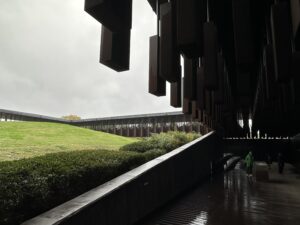 Reflecting on my trip, I find myself continually drawn back to the profound impact of the Equal Justice Initiative’s (EJI) Legacy Sites in Montgomery, Alabama. My visits to the National Memorial for Peace and Justice and the Legacy Museum were incredibly moving experiences. What struck me most was the meticulous attention to detail in every aspect of these sites. From their strategic locations to the intricacy of their architectural choices, it was evident that they were designed to evoke deep emotional responses through thoughtful aesthetics.
Reflecting on my trip, I find myself continually drawn back to the profound impact of the Equal Justice Initiative’s (EJI) Legacy Sites in Montgomery, Alabama. My visits to the National Memorial for Peace and Justice and the Legacy Museum were incredibly moving experiences. What struck me most was the meticulous attention to detail in every aspect of these sites. From their strategic locations to the intricacy of their architectural choices, it was evident that they were designed to evoke deep emotional responses through thoughtful aesthetics.
The National Memorial for Peace and Justice, set against the backdrop of downtown Montgomery, presented a vivid contrast. The beauty of its surroundings sharply juxtaposed the grave subject it honors: the more than 4,400 Black people killed in racial terror lynchings between 1877 and 1950. The transition from the welcoming green of the entrance to the oppressive atmosphere inside was immediate and striking. Upon entering, I encountered rows of over 800 steel slabs, each representing a county where lynchings took place, which corralled me into the somber experience. These slabs, initially resembling coffins, transformed into haunting representations of bodies as the path wound down, eventually leaving me beneath them. This experience was akin to moving through a forest and was both unsettling and deeply moving.
We then visited the Legacy Museum, a separate but connected experience. The museum further explored themes of racial injustice. A particularly striking feature that linked back to the Memorial was a wall of jars, each filled with soil from different lynching sites. This was a poignant connection to the Memorial and a stark reminder of the harsh realities they represent.
EQUAL JUSTICE INITIATIVE’S LEGACY MUSEUM, MONTGOMERY AL
Linda Blume
One of the experiences that continues to resonate for me is the opening exhibit at the Equal Justice Initiative’s Legacy Museum. Through a combination of sound, light, and sculpture we experience a bit of the ocean journey that enslaved people went through. Each of the realistic and emotionally moving sculptures in the exhibit was handcrafted by an artist and vividly depicts a unique individual and their humanity. As we listen to the waves rolling in, we learn that 12 million people were captured and brought here and that two million died on the journey. While I had learned, of course, about the “middle passage”, this exhibit gave me a new awareness and deeper understanding of the scale of this historical event, the human lives that were so abruptly disrupted and its continuing impact on our country and the world.
Vicki Comptor Lefkowitz
I participated in the Shomrei Civil Right trip in order to understand the concepts of slavery, to reconstruction to mass incarceration more deeply. In less than three days, I was exposed to so many of the injustices the black community has had to endure for hundreds of years. My understanding and empathy are greatly heightened, At the Equal Justice Initiative Museum, I found the stories of prisoners who spoke to me on the telephone on the other side of the glass from prison to be heartbreaking. Although they were only recordings and images of the incarcerated, their stories came across loud and clear. They epitomized one of the major issues black Americans are struggling with today, excessive punishment and economic and racial injustice. From meeting Linda Lowrey, who participated in Bloody Sunday and so many other marches, I understood how those who marched were so strong. I was awed how she and others learned to control their anger and how not to be perceived as a threat in any way. For example, they had to remove anything that could be seen as a weapon from their pockets (like a pen) in order to march peacefully. I still cannot imagine how much strength and courage they had in order to do so not only once but time but week after week often being jailed after each march.
I appreciated understanding the issues around the bus boycott —hearing and reading countless stories of enslaved men, women and children who were lynched for nothing at all, to the systemic racism that has our prisons overcrowded. I had not fully grasped the families torn apart when one master would sell the children or spouse of a slave, and the women that were used as breeders to make more slaves, All of the atrocities are shocking and allowed me to feel more connected to their suffering and to understand the challenges the black community still faces today.
Rosemary Steinbaum
The Montgomery sites on the trip were most vivid for me: the lynching memorial and the Brian Stevenson Legacy Museum of the Peace and Justice Initiative.
The depth of research and the visual impact of the lynching memorial moved me as the Viet Nam memorial does, somber, realistic, and transcendent. The names, the locales, dates, numbers of people lynched, all to enforce a reign of terror on the black population writ large, all memorialized on the rust/black metal hanging caissons — effective intellectually and imaginatively.
The Legacy Museum was overwhelming in its dense specificity, era by era, event by event, person by person. Near the end, I paused to listen to Fannie Lou Hamer’s testimony before Congress on a video reel. Her back story, from share cropping, to voting rights work, to beatings, to jail, and to congress, I knew from reading My Soul is Rested. There she was, speaking, somber, direct, unmoved. The president at the time of her testimony was Lyndon Johnson. So alarmed was he by thoughts of the ramifications of her testimony on the public that he called an impromptu press conference about nothing during her testimony in order to get the TV cameras off her and into the White House. It worked. Viewers and the press were baffled by his maneuver about nothing. And thus was white control maintained and black experience marginalized once more, over and over again.
SELMA, ALABAMA
Our Civil Rights Trip was an intense, educational, eye-opening and unforgettable experience. Reading & learning about slavery in school did not prepare me for what I learned and viscerally experienced during the trip. Before visiting the Equal Justice Initiative’s Legacy Museum, I did not fully comprehend the enormity, brutality and inhumanity of the US slave trade, including the overwhelming number (many millions) of people who were kidnapped & brought here as slaves, over hundreds of years. In addition to the Legacy Museum, hearing Linda Blackmon Lowery talk about her experiences as a 14 year old girl being viciously beaten on Bloody Sunday, along with her pride at completing the Selma to Montgomery march, made an everlasting & powerful impression on me. It was both heartbreaking and uplifting at the same time – I will never forget Linda’s response to a question about whether she felt hatred towards those who had beaten her & mistreated her. She said that she had “buried her hate in the ground and had only love in her heart” – and it was her faith that enabled her to do so. WOW!
Jeff Chanin
Many aspects of the Civil Rights tour were very impactful. The most powerful events of the trip were talking to Linda Blackmon Lowery and Reverend Calvin Woods, two people who participated in major events of the time. Linda was the youngest person to march the entire way from Selma to Montgomery. In addition to being a delightful person, she described her experiences being attacked and beaten on the Edmund Pettus bridge on Bloody Sunday, marching for mostly rainy five days, her PTSD, her joy at the rally at the Montgomery State House and her activist activities since the march that are ongoing today. During her talk, including a Q&A session, we laughed and cried with her. My emotions during the session were similar to those of talking with a holocaust survivor. I will never forget the privilege of interacting with Linda.
KELLY INGRAM PARK, BIRMINGHAM AL
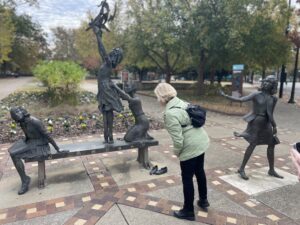 Susan Kitzen (Friend of Mike & Fran Legman)
Susan Kitzen (Friend of Mike & Fran Legman)
One particular part of our trip that I found especially moving was the visit to Kelly Ingram Park in Birmingham. Perhaps because we watched the powerful Spike Lee movie, Four Little Girls, as a group before the trip, I felt true heartbreak when I saw, first the outside of the repaired church, and then the park across the street with several sculptures and reminders of the events that occurred in Birmingham in 1963. First the sculpture of the four little girls frozen in time, just as they looked on the day they died, then the fierce attack dogs that snarled at and bit the marchers, then the bark of a tree, so damaged by the fire cannons that the city turned on the marchers to force them to flee, water streams so strong that they knocked the marchers down and marked the tree permanently–all of these images combined to bring to life the horrific history of the time and remind us that even the youngest were affected and harmed.
On reflection, one powerful memory I have from the trip was our walk through The Birmingham Civil Rights National Monument on our last day. Being at the site where Civil Rights activists and children marched and persisted despite police, hoses and dogs allowed me to be “in the shoes” of the protesters. As I walked through monuments where dogs were jumping at me from both sides, I felt their fear and appreciated their bravery. I was very aware of the fact that small and persistent actions by many individuals over time created the tide that swept through to make change. The trip in general was a reminder that we each have power to move ideas in a positive direction and that there is still much work to be done.
Gerry Blume
 A particularly memorable part of our Civil Rights trip was a simple tree. While throughout the trip we saw many examples of the bigotry and hatred that wafts across America’s history, it’s essence was captured by a tree in a park in Birmingham Alabama. The tree was there during the 1963 Children’s March during which children from the Black community marched for freedom. 3,000 children were arrested, but that was not the worst that they faced. The local police also turned German shepherds on them and used water cannons to push them back. The force of the cannons was so strong that they permanently damaged a tree in the park, leaving a scar that is still very visible 60 years later. The intensity of that water mirrored the intensity of the hatred that the South’s white society unleashed against its Black population. The tree stands as a testament to the courage of the marchers, even those who were children, to resist that hatred and to improve their lot.
A particularly memorable part of our Civil Rights trip was a simple tree. While throughout the trip we saw many examples of the bigotry and hatred that wafts across America’s history, it’s essence was captured by a tree in a park in Birmingham Alabama. The tree was there during the 1963 Children’s March during which children from the Black community marched for freedom. 3,000 children were arrested, but that was not the worst that they faced. The local police also turned German shepherds on them and used water cannons to push them back. The force of the cannons was so strong that they permanently damaged a tree in the park, leaving a scar that is still very visible 60 years later. The intensity of that water mirrored the intensity of the hatred that the South’s white society unleashed against its Black population. The tree stands as a testament to the courage of the marchers, even those who were children, to resist that hatred and to improve their lot.
ADDITIONAL REFLECTIONS
Reflections presented at the MLK Shabbat on January 13th: Reflecting on the Civil Rights Trip Experience
Some longer reflections:
- Reflections on the Civil Rights Trip: Changing My View of History by Ken Bannerman
- Impressions from the Civil Rights Trip by Ann Lippel
A summary of the trip by Aileen Grossberg: Reflection on the Civil Rights Trip: Personal Highlights
Images: Photos taken by Risa and Sol Bernstein, Sarita Eisenberg, Dale Russakoff and Karen Wirtshafter.

